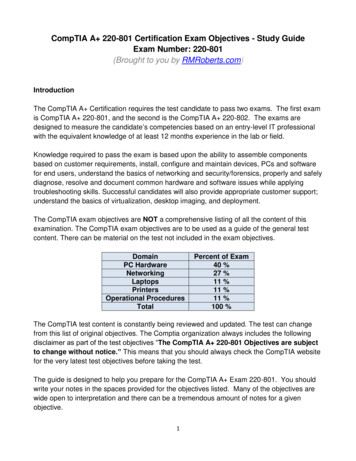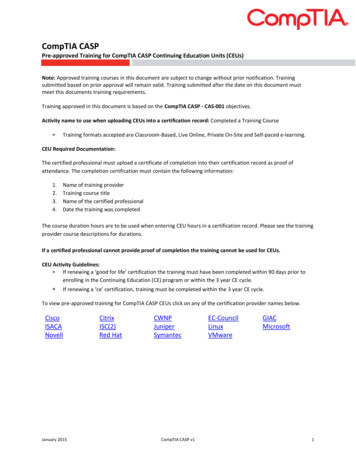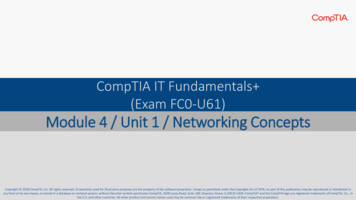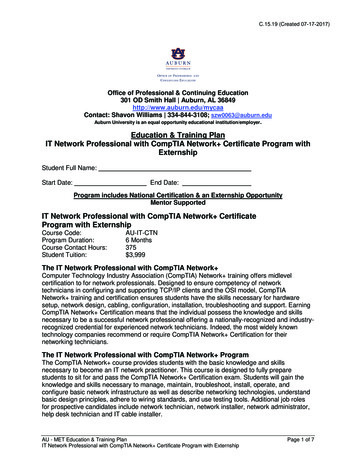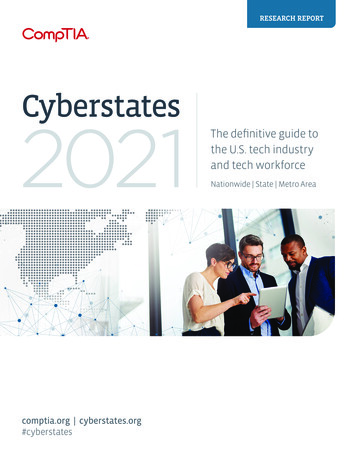
Transcription
RESEARCH REPORTCyberstates2021comptia.org cyberstates.org#cyberstatesThe definitive guide tothe U.S. tech industryand tech workforceNationwide State Metro Area
COPYRIGHT PAGECYBERSTATES 2021TMIS PRODUCED BYThe Computing Technology Industry Association (CompTIA)Copyright 2021 CompTIA,Inc. All rights reserved.CompTIA and Cyberstates areregistered trademarks ofCompTIA, Inc. in the U.S. andinternationally. Other brandsand company namesmentioned herein may betrademarks or service marks ofCompTIA, Inc. or of theirrespective owners.Any data or content used fromthis report should be properlysourced to CompTIA.Published in the U.S. March2021CompTIA is responsible for allcontent and analysis. Anyquestions regarding the reportshould be directed to CompTIAResearch and MarketIntelligence staff atresearch@comptia.org.Cyberstates can be accessedonline at Cyberstates.org.CompTIA3500 Lacey Road, Suite 100Downers Grove, IL 60515Phone: (630) 678 - 8300Copyright (c) 2021 CompTIA, Inc. CompTIA.org Cyberstates.org #Cyberstates Page 2
ABOUTABOUT COMPTIAThe Computing Technology Industry Association (CompTIA) is a leading voice and advocate for the 5 trillion global information technologyecosystem; and the estimated 75 million industry and tech professionals who design, implement, manage, and safeguard the technology thatpowers the world’s economy. Through education, training, certifications, advocacy, philanthropy, and market research, CompTIA is the hub foradvancing the tech industry and its workforce.CompTIA is the world’s leading vendor-neutral IT-certifying body with more than 2.8 million certifications awarded based on the passage ofrigorous, performance-based exams. CompTIA sets the standard for preparing entry-level candidates through expert-level professionals tosucceed at all stages of their career in technology. Through CompTIA’s philanthropic arm, CompTIA develops innovative on-ramps and careerpathways to expand opportunities to populations that traditionally have been under-represented in the information technology workforce.CompTIA Technology Career Pathway RoadmapCompTIA Certifications Job MatchCompTIA Training and LearningCompTIA Tech Career AcademyCompTIA IT Salary CalculatorCompTIA Member Communities and CouncilsABOUT CYBERSTATESCompTIA designed Cyberstates to serve as a reference tool, making national, state, and metro area-level data accessible to a wide range ofusers. Cyberstates quantifies the size and scope of the tech industry and the tech workforce across multiple vectors. To provide additionalcontext, Cyberstates includes time-series trending, average wages, business establishments, job postings, gender ratios, innovation andemerging tech metrics, and more. For the interactive online version of Cyberstates, visit www.cyberstates.org.As with any sector-level report, there are varying interpretations of what constitutes the tech sector and the tech workforce. Some of thisvariance may be attributed to the objectives of the author. Is the goal to depict the broadest possible representation of STEM and digitaleconomy fields, or a more narrowly defined technology subset? Is the goal to capture all possible knowledge workers, or a more narrowlydefined technology subset? For the purposes of this report, CompTIA focuses on the more narrowly defined technology subset. See themethodology section for details of the specific NAICS codes and SOC codes CompTIA uses in its definitions of the tech sector and the techworkforce.Due to periodic updates to industry and occupation categories by the U.S. Bureau of Labor Statistics, as well as occasional revisions of historicaldata, direct comparisons to previous publications of Cyberstates is not always possible. Additionally, CompTIA adjusts its methodology at timesto best reflect available data and the needs of users. For these reasons, it is best to view the most recent release as the best representation ofthe state of the tech industry and workforce. If historical comparison data is required, requests can be submitted to research@comptia.org.CompTIA’s base of IT certification holders spans 232 countriesCopyright (c) 2021 CompTIA, Inc. CompTIA.org Cyberstates.org #Cyberstates Page 3
TABLE OF CONTENTSBACKGROUND AND KEY FINDINGS5NATIONAL SNAPSHOT15STATE SNAPSHOTS17METRO AREA SNAPSHOTS69APPENDIX TABLES - A121NET TECH EMPLOYMENT TRENDING BY STATENET TECH EMPLOYMENT TRENDING BY METRORANKINGS: NET TECH EMPLOYMENT BY STATERANKINGS: NET TECH EMPLOYMENT BY METROAPPENDIX TABLES - B128TECH WORKFORCE CHARACTERISTICS BY RACE AND ETHNICITY BY STATETECH WORKFORCE CHARACTERISTICS BY RACE AND ETHNICITY BY METROTECH WORKFORCE CHARACTERISTICS BY GENDER BY STATETECH WORKFORCE CHARACTERISTICS BY GENDER BY METROTECH WORKFORCE CHARACTERISTICS BY OCCUPATION BY AGETECH WORKFORCE CHARACTERISTICS BY INDUSTRYTECH WORKFORCE CHARACTERISTICS BY IT CHANNELAPPENDIX TABLES - C136TECH EMPLOYMENT OUTLOOK BY OCCUPATION: 2020-2030TECH EMPLOYMENT OUTLOOK BY STATE: 2020-2030TECH EMPLOYMENT OUTLOOK BY METRO: 2020-2030APPENDIX TABLES - D140TECH WAGE PERCENTILES BY STATETECH WAGE PERCENTILES BY METROTECH ECONOMIC IMPACT BY STATETECH ECONOMIC IMPACT BY METROAPPENDIX TABLES - E145JOB GROWTH COMPARISONS ACROSS INDUSTRY SECTORSMETHODOLOGY147BACKGROUNDTECH INDUSTRY AND OCCUPATIONS CLASSIFICATIONSCopyright (c) 2021 CompTIA, Inc. CompTIA.org Cyberstates.org #Cyberstates Page 4
DEFINING NET TECH EMPLOYMENTThe tech workforce consists of two primary components, represented as a single figure by the ‘net tech employment’ designation. Thefoundation is the set of technology professionals working in technical positions, such as IT support, network engineering, softwaredevelopment, data scientist, and related roles. Many of these professionals work for technology companies (46.5 percent), but manyothers are employed by organizations across every industry sector in the U.S. economy (53.5 percent).The second component consists of the business professionals employed by technology companies. These professionals – encompassingsales, marketing, finance, HR, operations and management, play an important role in supporting the development and delivery of thetechnology products and services used throughout the economy. Slightly more than 34 percent of the net tech-employment total consistsof tech industry business professionals.One final segment involves workers classified as self-employed. For the purposes of this report, only dedicated, full-time self-employedtechnology workers are counted towards net tech employment. Workers that are characterized as “gig” workers, which may entailworking on the side for supplementary income, are excluded from this analysis due to several uncertainties with the data and to minimizethe possibility of double counting.N Technology professionals employed across the economy, including in the tech sector(e.g. software developers, network architects, database admins, etc.)N Tech sector employment, less technology professionals(e.g. sales, marketing, finance, HR, etc.)12.4 million66%Projected totalworkers in 2021 100,000 workers% of NET techemployment isin technologyoccupationsSource: EMSI U.S. Bureau of Labor Statistics CompTIASome numeric changes affected by roundingCopyright (c) 2021 CompTIA, Inc. CompTIA.org Cyberstates.org #Cyberstates Page 5
YEAR IN REVIEWNET TECH EMPLOYMENT TRENDINGKEY POINTS The global pandemic devastated many sectors of the U.S.economy and labor market. During April 2020 alone, more than20 million Americans lost their jobs leading to an unemploymentrate approaching levels not seen since the Great Depression.20152017201820192020est.2021proj .Software [general purpose]Tech ManufacturingMILLIONS OF WORKERS6.0Telecommunications and Internet Services4.0R&D, Testing, and Engineering Services2.0IT Services and Custom Software Services0.0201520162017201820192020est.2021proj .TECH OCCUPATION EMPLOYMENT TRENDINGCore Information Technology (IT) OccupationsEngineering, Technician, Repair, Install Occupations8.0MILLIONS OF WORKERS Top projected growth occupations for 2021: 4.4% Cybersecurity 4.4% Data Scientists 3.7% Software Developers and Software QA 2.6% Web Developers and Digital Interface Designers 2.4% CIOs and IT Managers 2.2% Database Administrators and Architects 2.2% IT User Support Specialists2016TECH INDUSTRY EMPLOYMENT TRENDING8.0 Among the components of net tech employment, the tech sectorside of the equation experienced estimated growth of 1.0%,while the occupation side across all industry sectors experienceda modest loss of -0.3%. Looking ahead, the segmentencompassing tech occupations employed in the tech sector isprojected to expand hiring the fastest. The occupation side of the equation within the tech sector itself(tech professionals working for a tech company) is projected tocontribute most to growth in the year ahead at 2.9%, with theother two components contributing in the 1.4% to 1.9% range.10.08.0 Additionally, several prominent tech and telecom companies hadretail divisions where staffing cutbacks occurred in sales,marketing, or customer service, while core technology positionswere preserved. Lastly, the IT services segment of the industry isdominated by small businesses serving primarily other smallbusinesses, tends to be more vulnerable to economic shocks. At the time of writing, tech employment was off to a strong startduring the first two months of 2021. If the momentum continuesand the U.S. economy returns to a degree of normalcy, net techemployment could reach its projected target of 245,514 net newworkers added or 2.0% growth.11.09.0 These positives, however, were offset by reductions orpostponements in spending and hiring of tech workers,especially in the hardest hit industry sectors of transportation,hospitality, entertainment and related. Net tech employment in the United States – as described on theprevious page, reached an estimated 12,159,552 workers in2020, essentially flat year-over-year. Of that number, just 11,916were net new workers, representing just 0.1% growth. 245,514 2.0% 11,916 0.1%12.0MILLIONS OF WORKERS The tech sector and the broader base of technology workersemployed across the economy experienced several bumpsduring this turbulent period, but generally held up well. In somecases, demand for technology services and infrastructure tosupport new remote work models, ecommerce, or revampedsupply chains exploded, stretching the capacity of solutionproviders and 021proj .Source: EMSI U.S. Bureau of Labor Statistics CompTIACopyright (c) 2021 CompTIA, Inc. CompTIA.org Cyberstates.org #Cyberstates Page 6
INDUSTRY SECTOR COMPARISONSINDEX OF 2020 MONTHLY EMPLOYMENT CHANGES ACROSS INDUSTRY SECTORSNote: chart intended to show relative positioning of the tech industry to other sectors105Fin an ce an d ins uranceTechRetail95Con stuctionHealthcareLegal Services85Real Es tateAuto Manufacturing75EducationFood and Drinking PlacesAir Transp ortatio n6555Arts and EntertainmentSevere industrysector job lossesAccommodation and Hotels45JanFebMarAprMayJunJulAugSepOctNovDec In the hardest hit industry sectors, suchas Food and Drinking Places or Hotels,employment contracted severely andhas still not recovered. Total U.S.employment remains nearly 10 millionworkers short of pre-pandemic levels. Despite a few bumps, tech industryemployment held up reasonably well.TOTAL PROJECTED EMPLOYMENT GAINS IN 2021 ACROSS INDUSTRY SECTORSNote: the Tech Industry spans multiple sectors so there will be a degree of double-counting graph intended for comparison purposesHealthcare and So cial Assistance 529,920Profess ion al, Scientific, and Technical Services 246,752Tech Indu stry 182,383Tran sportation an d Warehou sin g 174,408Con struction 123,729Administrative an d Supp ort 107,946Manufacturing 102,388Govern ment 92,178Accommodation and Foo d Services 84,449Educational Services 73,206Fin an ce an d Insuran ceManagemen t of Companies and Consu lting 72,449 41,766Arts, Entertainment, and Recreation 29,628Real Es tate and Ren tal and Leasin g 25,669Wholesale Trade 25,348Information 22,322Minin g, Qu arrying, and Oil and Gas 8,502Agriculture, Forestry, Fishing and Huntin g 6,065UtilitiesRetail In the year ahead, the U.S. labormarket is projected to expand bynearly 1.8 million net new jobs. Asnoted in the chart above, the gains inmany sectors represent thebackfilling of lost jobs and a return topre-pandemic levels. On a numeric basis, the massiveHealthcare sector is projected to addthe most net new jobs at more than500,000 in the year ahead. On apercentage basis, the Transportationand Warehousing sector is projectedto lead the way, signaling a return ofrecovery hiring as well as new hiringspurred by the need for deliveryservices. The Tech industry ranks third inprojected employment growth 3,976No projected growth See Appendix for more comparisondata.Copyright (c) 2021 CompTIA, Inc. CompTIA.org Cyberstates.org #Cyberstates Page 7
THE DECADE AHEADTECH OCCUPATION EMPLOYMENT OUTLOOKKEY POINTS Calculating future workforce needs over the next decade is afunction of several variables. First, there is a growthcomponent, which may entail organizations adding headcountdue to expansion or possibly to support new emergingtechnologies. Secondly, there is a retirement factor, with aportion of the workforce transitioning away from the workforcepermanently. And lastly, there is a segment leaving theworkforce for some other reason, also referred to asseparations. These may stem from a career change, a return toschool, family pursuits, or other. Changes to any of thesevariables can boost or shrink future workforce projections.Additional hiresneeded to offsetretirements andworkforceseparationsMILLIONS OF WORKERS By 2030, projections from the U.S. Bureau of Labor Statisticsand EMSI put the base of tech occupation employment atapproximately 9.0 million (note: this covers occupations onlyand represents a subset of the net tech employment figurepresented previously).Workforce need annual replacement rate growth rate6.42010 The average replacement rate for tech occupations during2020-2030 is expected to average about 7 percent annually, ornearly 580,000 workers each year, totaling several millionthrough 2030. This is in addition to the workers needed due togrowth.1,500,000 Tech occupation employment is expected to grow at abouttwice the rate of overall employment across the economy.Many tech occupations will grow at 4x to 5x the national rate.See Appendix for detailed 2020-2030 comparisons.1,100,000 Cybersecurity, 31%Data Scientists, 30%Software Developers, 23%Web Developers, 15%CIOs and IT Managers, 14%Database Admins and Architects, 13%IT Support Specialists, 13%Systems Analysts and Engineers, 12%9.08.020202030AGGREGATE QUARTERLY JOB POSTINGSFOR TECH OCCUPATIONSJob postings by U.S. employers1,300,000900,000700,000500,000 Job posting data provides another layer of insight into the techjob market outlook. Because government labor taxonomies –Standard Occupation Codes (SOCs), lag the speed with whichthe market changes, job posting data provides a more up-todate look at the skills and experiences employers seek. Overall quarterly tech job postings among U.S. employersdipped during 2020 due to the pandemic slowdown. Postingsrebounded in Q1 2021 with employers playing catch-up withpent-up demand. Note: job postings should not be interpretedas unfilled jobs and there is not a 1:1 relationship betweenpostings and actual hires made. Demand for emerging tech skills and experiences continue togrow as employers across industries pursue digitaltransformation strategies. Over the past five years, postingvolume surged 190 percent, as employers sought skills andexpanded job roles in areas such as emerging infrastructure,emerging hardware, artificial intelligence, data, and next-gencybersecurity.Source: EMSI U.S. Bureau of Labor Statistics Burning Glass Labor Insights CompTIAQ1 Q2 Q3 Q4 Q1 Q2 Q3 Q4 Q1 Q2 Q3 Q4 Q1 Q2 Q3 Q4 Q1'17 '17 '17 '17 '18 '18 '18 '18 '19 '19 '19 '19 '20 '20 '20 '20 '21proj.EMERGING TECH DEMAND RAMPS UPAnnual emerging tech job postings by U.S. employers 190%Growth inemerging techannual 17201820192020Copyright (c) 2021 CompTIA, Inc. CompTIA.org Cyberstates.org #Cyberstates Page 8
THE MANY FACETS OF WAGE DATAKEY POINTSMEDIAN ANNUAL OCCUPATIONAL WAGE COMPARISON There are many nuances to the tech wage discussion. At theindustry level – meaning the universe of technology companiesin the sector, wages encompass all staff positions, from the CEOdown to entry-level helpdesk workers. Both technical and nontechnical positions factor into the industry wage calculation.Because of the diversity of positions covered, interpretingsummary industry wage data requires accounting for thesefactors. In comparison, tech occupation wages cover onlytechnical positions. This is the primary focus of the wage dataof this report. 75K 50K 25K 0K10th percentile25th percentile50th(median)75th percentile90th percentileTECH WAGES CAN VARY SIGNIFICANTLY BASED ONOCCUPATION, LOCATION, AND PERCENTILE Percentiles help provide insight into wage ranges. Thisapproach minimizes the impact of outlier data points, such asworkers receiving massive stock payouts. It is also useful indepicting wages along common career paths, with workers juststarting out earning wages at the 10th percentile, and then withexperience and additional training and certification, moving upthrough the higher wage levels. When drilling down to the metro area level, wage differencesmay become even more pronounced. Top tier wages inlocations such as San Jose or New York City may run intohundreds of thousands, if not more when factoring in bonusesor stock options.89%higher 100K Beyond location, the other important variables to considerwhen reviewing wage data are job role, areas of expertise, jobexperience, industry sector, and company size. A skilledemployee in a hot field such as artificial intelligence, workingfor a Fortune 500 company, will earn on average far more thana tech worker in an established field, working for a smallbusiness in a rural area. 200KCalifornia softwaredeveloper at 90thpercentile 175K 150KTECH WAGE PERCENTILES The scatterplot graph to the right illustrates the degree towhich wages will differ across states. The data presents wagesfor software developers and IT support specialists acrosspercentiles. Tenth and 25th percentiles often correspond toearly-stage career positions (e.g. 0-4 years of experience), while75th and 90th percentiles cover higher-end experience andexpertise.Median Tech Wage 125K Cost of living differences mean the wages in one location arenot directly comparable to another. For example, the buyingpower of a salary in San Francisco will not go nearly as far as inDes Moines. According to the National Association of Realtors,the median price for a home in Silicon Valley exceeds 1.1million. See CompTIA’s Tech Town Index for guidance on techwages relative to cost of living or See CompTIA IT SalaryCalculator for detailed wage data across 400 metro areas. Across all tech occupation categories covered by Cyberstates,the median wage, also referred to as the 50th percentile ormidpoint, was an estimated 86,852 in 2019, the most recentyear of available data. This figure is nearly double the medianwage across all occupations of the U.S. labor force.Median National Wage 150K 125KNew Jersey ITsupport specialistat 90th percentile 100K 75K 50KNew MexicoIT supportspecialist at25th percentile 25K 0K10th percentile25th percentile75th percentile90th percentileSource: EMSI U.S. Bureau of Labor Statistics CompTIACopyright (c) 2021 CompTIA, Inc. CompTIA.org Cyberstates.org #Cyberstates Page 9
KEY FINDINGS – TECH WORKFORCE CHARACTERISTICSTECH WORKFORCE CHARACTERISTICS2LABOR FORCE CHARACTERISTICS OVERVIEWU.S. tech occupation representation The U.S. Bureau of Labor Statistics (BLS) tracks labor market composition across severaldemographic and firmographic characteristics. By race and ethnicity, the BLS segmentsdata by seven top-level categorizations. Described in detail here:§§§American Indian and Alaska NativeAsianBlack or African American§§§§Black or African Hispanic orAmericanLatinoHispanic or LatinoNative Hawaiian and Other Pacific IslanderTwo or More RacesWhite Additional population segmentations are available from the Census Bureau, but for thepurposes of analyzing labor market compositions of specific occupation categories, theseven categories above are the extent of data availability.8%7%13%16%Women26%49%vs. representation across all U.S. occupationsEXAMPLES OF TECH JOB REPRESENTATION2VS. ALL JOBS IN STATE REPRESENTATIONDIVERSITY INDEX There are several approaches to assessing labor force characteristics. Numeric totals andrelative percentages are good starting points. Taking it a step further, however, providesdeeper insights and more context.BLACK OR AFRICAN AMERICANREPRESENTATION To measure overall race and ethnicity characteristics within the tech workforce, thisreport uses a metric called Simpson’s Diversity Index. This index weights two key facets ofrace and ethnicity within the workforce – richness and evenness (or think of it as depthand breadth) and reflects it in a single metric. The overall U.S. workforce Diversity Index measure in 2020 was 56 on a 100-point scale. Incomparison the overall U.S. population has a Diversity Index score of 58, which indicatesthere is a degree of race and ethnic underrepresentation in the U.S. workforce. The U.S. tech workforce (specifically, workers in core information technology across 16occupation categories) recorded a Diversity Index measure of 57, roughly on par with theoverall U.S. workforce. The District of Columbia recorded the highest tech workforceDiversity Index score at 66, followed by Texas, California, and Georgia. In contrast, thestates at the other end of the continuum had tech workforce Diversity Index scores below20.TechJobsAllJobsDistrict of nd20%27%HISPANIC OR LATINO REPRESENTATONTECH WORKFORCE REPRESENTATION As the name implies, tech workforce representation measures the composition of thetech workforce relative to the overall composition across all occupations. Nationally, Black or African American workers represent 13% of the U.S. workforce and8% of tech occupations. This gap signals underrepresentation in the tech workforce.Examples of states with high levels of tech workforce representation numerically and inrelation to the overall workforce composition include District of Columbia, Mississippi,Georgia, and Maryland.TechJobsAllJobsNew OMEN REPRESENTATION Nationally, Hispanic or Latino workers represent 16% of the U.S. workforce and 7% of techoccupations. This gap signals underrepresentation in the tech workforce. Examples ofstates with high levels of tech workforce representation numerically and in relation to theoverall workforce composition include New Mexico, Florida, Texas, and Arizona. Nationally, women represent approximately 49% of the U.S. workforce and 26% of techoccupations. This gap signals underrepresentation in the tech workforce. Examples ofstates with high levels of tech workforce representation in relation to the overallworkforce composition include South Carolina, Maine, Wisconsin, and Louisiana.TechJobsAllJobsSouth 8%51%2Data covers core tech occupations See Appendix fornumerical valuesSource: EMSI U.S. Bureau of Labor Statistics CompTIACopyright (c) 2021 CompTIA, Inc. CompTIA.org Cyberstates.org #Cyberstates Page 10
KEY FINDINGS – NATIONAL EMPLOYMENTU.S. NET TECH EMPLOYMENTU.S. NET TECH EMPLOYMENT U.S. net tech employment totaled an estimated 12.2 million in 2020, essentially flat whencompared to the previous year. Net tech employment is projected to grow at anestimated 2.0 percent year-over-year reaching 12.4 million in 2021. Net tech employment accounted for approximately 7.9 percent of the overall U.S.workforce in 2020. As noted previously, because of the blurring of lines across industries,there is a degree of undercounting in tech sector employment.2020 est. 2021 proj.Tech employmentnet of industry,occupation, and selfemployed12.2m12.4m 254,514Total12.2m12.4m 254,514U.S. TECH INDUSTRY EMPLOYMENTU.S. TECH INDUSTRYEMPLOYMENT U.S. tech industry employment totaled an estimated 7.7 million in 2020, an increase of79,540 workers from 7.6 million in 2019. Tech industry employment is projected to growat an estimated 2.4 percent year-over-year reaching 7.8 million in 2021. As noted, techindustry employment is a subset of net tech employment. Tech manufacturing employment totaled an estimated 1.2 million in 2020 and isprojected to grow by 10,602 jobs in 2021. Among the seven major tech manufacturing subsectors – the OEMs and companiesproducing computing hardware, peripherals, semiconductors, etc., two are projected toexperience employment losses, while the remaining categories are projected toexperience job gains. Employment in the telecommunications and Internet services sector totaled an estimated1.4 million in 2020, projected to go up by 11,391 jobs in 2021. These employment gainsare driven by growth in the data processing, hosting, and search portal servicescategories, where employment should increase by 29,157 jobs. Wired and wirelesstelecommunications services are projected to lose 18,882 jobs for the same time period.2020 est. 2021 proj.NumericChangeTech Manufacturing1.2m1.2m 10,602Telecommunicationsand Internet Services1.4m1.4m 11,391Software [packaged]0.5m0.5m 25,720IT Services & CustomSoftware services2.7m2.8m 102,662Engineering Services,R&D, and Testing1.9m2.0mTotal7.7m7.8m 182,383 The software category, consisting of general purpose software that is not customdeveloped, also known as published or packaged software products (including SaaS),employed an estimated 483,966 workers in 2020, and is projected to add more than25,000 net new jobs. On a percent change basis, software will lead the tech sector with a5.3 percent projected year-over-year growth rate. The IT services and custom software services subsector will generate the largest numericalgain in employment, adding more than 102,000 net-new jobs in 2021. This gain of 3.8percent will increase the employment base to 2.8 million. This growth reflects the ongoingdigital transformations occurring across the economy and the corresponding need forexpertise in areas such as cloud computing migration, application integration, processautomation, data analytics, and cybersecurity.NumericChange 32,007U.S. TECH OCCUPATIONEMPLOYMENT2020 est. 2021 proj.NumericChangeIT Occupations5.2m5.3m 131,878Engineering andTechnicianOccupations2.8m2.9m8.0m8.2m 166,879Total 35,001TOP TECH OCCUPATION KEYCATEGORIESU.S. TECH OCCUPATION EMPLOYMENT Tech occupation jobs reached an estimated 8.0 million workers in 2020 and is projectedto increase 166,879 jobs in 2021 . On a percent change basis, the rate is on par with theannual growth rates experienced over the past several years.Software, Programmers,Web and QA Since 2015, nearly 870,000 new tech occupation jobs were added, a function of thedemand for tech talent across every industry sector in the economy. The IT occupations segment of tech occupations accounts for 65 percent of the total. IToccupations is projected to add over 130,000 net-new jobs in 2021, a year-over-yeargrowth rate of 2.5 percent. On a numeric basis, software developers, systems analysts andcybersecurity analysts, network architects, and IT support specialists recorded the largestgains in employment. The U.S. Bureau of Labor Statistics does not yet break out manyemerging tech roles, other data sources indicate these new specialties are starting tomake meaningful contributions to the growth of the tech workforce.2021 proj. % Change1,939,788 3.3%Cybersecurity and SystemsAnalysts and Engineers757,509 2.5%Network Admins., Architectsand Support701,794 1.7%IT Support Specialists672,908 2.2%Database, Data Scientists andComputer Scientists197,598 2.7%Source: EMSI U.S. Bureau of Labor Statistics CompTIASome numeric changes affected by roundingCopyright (c) 2021 CompTIA, Inc. CompTIA.org Cyberstates.org #Cyberstates Page 11
KEY FINDINGS – STATE EMPLOYMENTSTATE NET TECH EMPLOYMENT Twenty-two states experienced job gains in net tech employment from 2019 to 2020.Forty-nine states are projected to generate positive tech employment job growth in2020. While the largest job gains are associated with the states with a significant techpresence, the fact that most states experienced tech employment job gains speaks tothe broad-based impact of technology across the nation. On an industry sector basis, the software services sector has been the growth engine forthe greatest number of states over the past year. Year-over-year distribution of counts oftop categories by state: Software: 43 statesR&D, Testing, and engineering services: 42 statesIT services/custom software services: 38 statesTelecommunications: 24 statesTech manufacturing: 17 states The metrics used to provide context and insight into the data tend to be based onabsolute size or are relative, which may involve percent change or account for factorssuch as population or economic size differences. Absolute measures tend to be highlycorrelated with the size of the state or metro area. For example, California is the largeststate in the nation by a wide margin. Its population is 40 percent larger and its economyis 54 percent larger than second place Texas. California’s economy is equal to thecombined total of the bottom 25 states. Unsurprisingly, California is the leader in manyCyberstates categori
CompTIA Certifications Job Match CompTIA Training and Learning CompTIA Tech Career Academy CompTIA IT Salary Calculator CompTIA Member Communities and Councils ABOUT CYBERSTATES CompTIA designed Cyberstates to serve as a reference tool, making national, state, and metro area -level data accessible to a wide range of users.






